Research
2019-05-05
2527[Abstract]
Due to the increasingly prominent problems of energy shortage and environmental pollution caused by traditional cars, new green transportation vehicles such as new energy vehicles have emerged and become the "new favorite" of major car manufacturers. In new energy electric vehicles, the battery pack is the core component, and the sealing of the battery pack directly affects the safety of the battery system operation, thus also affecting the overall safety of the vehicle. In order to improve the sealing and waterproof performance of battery packs, it is necessary to design the sealing structure of the battery box body reasonably, study the structure and materials of the sealing strip, and achieve a perfect combination of the battery box body and sealing strip structure. This will have important application significance and guiding value for ensuring the safety of battery packs, improving their service life, and future development directions.
Keywords: New energy vehicle battery pack, silicone rubber foam sealing strip, waterproof
Classification number: U465.4; U469.72
1 Overview
In the increasingly severe situation of global energy shortage and climate change, people's call for new energy is becoming more and more urgent, and as a major energy consumer, cars need to keep up with the times and adapt to the needs of environmental protection. Therefore, new energy vehicles are predicted as the ultimate trend of future automotive development.
With the development of electric vehicles, the performance and safety of battery packs as the power source of new energy vehicles directly determine the overall safety of the vehicle. If the battery pack is flooded, it will seriously affect its performance, so higher requirements have been put forward for the sealing and waterproof function design of the battery pack structurally.
Traditional battery pack waterproofing methods generally involve sealing, applying sealant, on-site rubber foaming, etc. However, we know that these traditional methods have many drawbacks and defects, such as the inability to repair or high maintenance costs of battery packs, complex production processes, insufficient waterproof sealing performance, and susceptibility to aging. The waterproof structure of the foam sealing strip we designed can avoid these drawbacks and defects, making the installation of the battery pack more convenient, the maintenance cost lower, and meeting the requirements of new energy vehicle battery packs for complex and harsh environments.
2 Sealing structure form and principle
Due to the low installation position of battery packs in electric vehicles and their exposure to relatively open spaces, they are susceptible to rain and snow weather, especially when the car is submerged in water and must withstand a certain amount of water pressure. Therefore, greater requirements have been put forward for the waterproof structure design of sealing strips. The following focuses on introducing the sealing principle and design of foam sealing strips.
2.1 Waterproofing of Foam Sealing Strip and Contact Interface
The waterproof principle of silicone rubber foam sealing strip: The silicone rubber sealing strip will undergo elastic deformation under pressure, filling the gap between the contact interface and the sealing strip and generating rebound force, thereby generating friction between the contact surface and the foam sealing strip. When the sealing strip itself does not leak, the sealing material will not leak due to deformation or displacement when the frictional force and rebound force are greater than the internal or external pressure of the sealed medium. Otherwise, leakage will occur.
The following diagram shows the sealing structure, and elastic deformation also refers to the compression rate of the sealing gasket, denoted as C. Compression ratio C=(H1-H2)/H1 × 100% (H1 refers to the section height of silicone rubber foam in free state, H2 refers to the section height in compression state.)
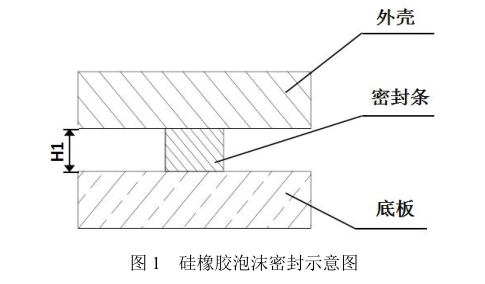
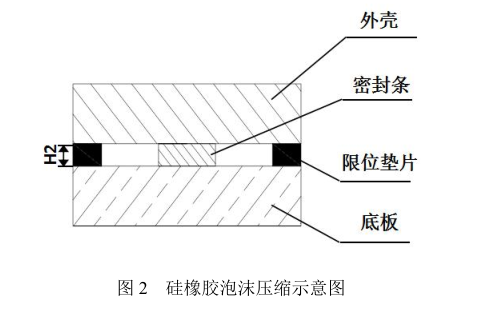
The rebound force generated after compression (also known as CFD) mentioned earlier refers to the response force of silicone rubber to the applied object after being compressed to a certain proportion and reaching mechanical equilibrium. For the same silicone rubber, the larger the compression ratio, the greater the rebound force, and the better its sealing and protection effect. However, if the compression amount is too large, it will also adversely affect the fixation of silicone rubber foam itself and the interface.
The following figure shows the comparison of our silicone rubber foam TY640 product, a foreign R brand product 800 series product and a domestic high-temperature rubber CFD:
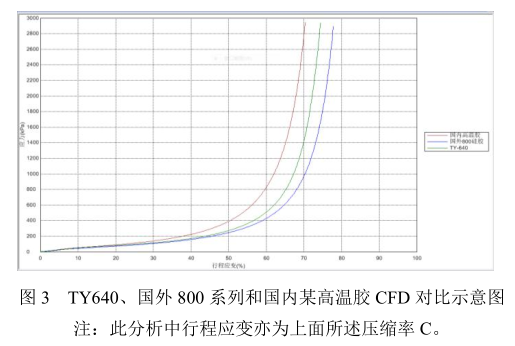
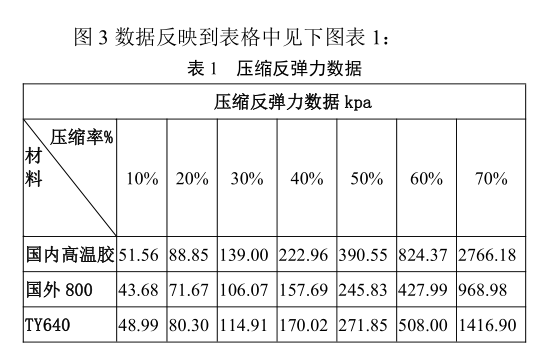
It can be seen from the CFD diagram that the changes of CFD of TY640 series, foreign 800 series and a domestic high-temperature adhesive are relatively similar in the process of stroke strain change. When the compression ratio is below 50%, the CFD slowly increases with the increase of compression ratio, which is mainly caused by the changes of air in foam materials being compressed; When the compression ratio is higher than 50%, the air in the foam material is fully compressed, and the silicone rubber material itself is compressed, thus showing a sharp increase in CFD. Therefore, when using silicone rubber foam sealed battery packs, the compression ratio should not be too high or too low; If it is too low, the CFD is small, and the liquid with certain pressure will deform the foam material and cause the liquid to flow into the interior along the interface; If the compression ratio is too high, the CFD will increase accordingly, causing deformation of the battery pack bottom plate and shell, which will make it difficult to process and seal. It will also prevent the contact interface from fully filling the seal, resulting in leakage of external liquids during later use. Based on our years of experience in this industry, it is recommended to maintain a compression ratio of 30-50%. In addition, the waterproof performance of silicone rubber foam seal is related to not only the compression rate, but also the width of foam sealing strip. Generally speaking, the wider the width, the better the sealing effect. The specific optimum width shall also be determined in combination with the density of foam sealing strip, pore structure type and closed pore ratio.
2.2 Effect of silicone rubber foam material on waterproof performance
General sealing strip materials, such as ordinary solid rubber and ordinary foam materials, can be used in situations where the waterproof level requirements are not high, and these materials can achieve a waterproof level of IP45. The waterproof grade is required to be higher, and the advantages of silicone rubber foam sealing strip are shown. This is because silicone rubber foam is a new type of high and low temperature resistant polymer elastic material, which is characterized by excellent high temperature resistance and cold resistance, as well as excellent aging resistance (ozone resistance, oxidation resistance, radiation resistance, light resistance, weather resistance). During long-term use, it has very good elastic deformation, small thickness loss, and can withstand aging, high temperature, high humidity. The waterproof grade can reach IPX7 and IPX8.
How does the structure of silicone rubber foam material determine its waterproof performance?
2.2.1 Influence of pore structure type of silicone rubber foam material on waterproof performance
Silicone rubber foam materials can be divided into closed cell, open cell and mixed (also called semi continuous foam) structures according to the type of pore structure. At present, the sealing and waterproofing of battery packs on the market are mainly closed cell type and mixed type, of which the closed cell type is mainly high temperature silicone rubber, which has excellent waterproof and air tightness at the beginning of use. However, with the extension of service time, the foam material cannot be restored as before due to its molecular structure, resulting in overall collapse and decline in sealing and waterproofing performance. The specific reasons will be described below; At the same time, it is difficult to maintain the consistency of the closed cell structure of the product for the foam adhesive prepared by the high-temperature adhesive, which is mainly determined by the foaming principle, and will be analyzed later in combination with the product. The hybrid structure, currently dominated by the 800 series of a certain foreign brand, has excellent weather resistance and resilience. After long-term use, it can still recover to its original state, but there is no guarantee in terms of waterproof performance. We have verified through multiple batches of experiments that when the compression rate is low (such as less than 30%), the waterproof performance cannot pass for a long time. If the compression rate is increased (such as greater than 50%), the waterproof performance can be increased, but it still cannot guarantee 100% waterproofing, and there are differences between batches; If the compression ratio is further increased, waterproofing may be achieved, but it will have an impact on the design of the sealing structure and increase many uncertainties. The main reason for the poor waterproof performance mentioned above is related to the porosity rate; The higher the opening rate, the higher the probability of communication between bubbles, which leads to a decrease in waterproofing and airtightness. Therefore, we carried out SEM scanning on the internal cellular structure of foam material to observe the pore size distribution, as shown in the following figure:
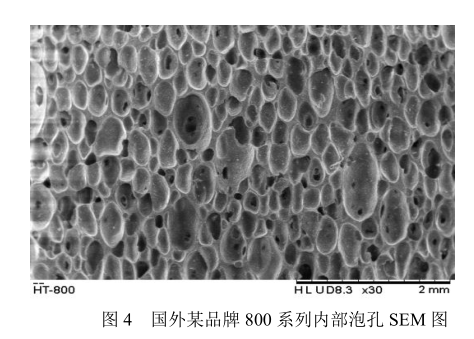
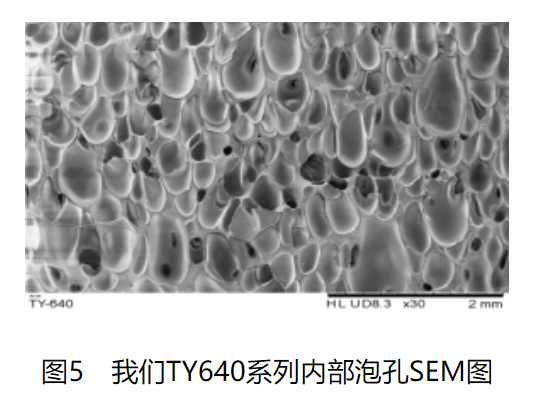
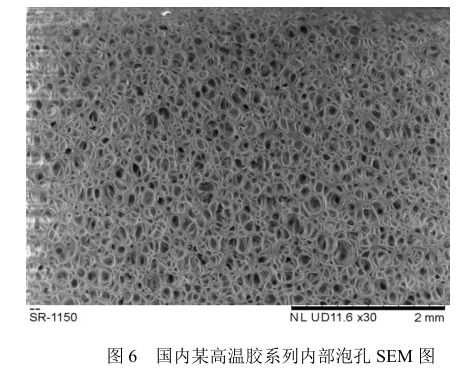
From the comparison of the SEM images above, it can be seen that both the 800 series and TY640 series have interconnected pores, but the latter has significantly fewer pores, with a lower opening rate than the former, resulting in better waterproofing and airtightness under the same compression ratio conditions. Compared to others, a certain high-temperature adhesive foam in China has a high connectivity rate, resulting in poor waterproof and airtight performance of the material. This is due to the self foaming principle of high-temperature foam silicone rubber. The high-temperature rubber foaming is a foam material produced by introducing an independent foaming agent and releasing gas at high temperature. It does not participate in the foaming reaction itself, so the pore structure is difficult to control, resulting in poor product consistency. In addition, TY640 can also have the same rapid rebound performance as the 800 series under different aging conditions after long-term use testing, with minimal or even better thickness loss.
There was no collapse during use, which is a challenge for porous materials with low porosity. Through our in-depth research on the material, we found that within the normal compression range, the compression mainly involves compressing the air inside the bubbles, which can achieve rapid rebound. When the compression exceeds 80%, some gas is discharged through the bubble wall. The bubble wall of TY640 material has excellent support, and even if the air is discharged, it can still ensure the rebound of the material, resulting in minimal thickness loss. We can ensure this through strict internal aging testing and repeated compression waterproof testing.
The above is a discussion on waterproof performance. Next, let's take a look at the airtightness of the material.
Why is it said that foam materials with high opening rate can achieve waterproof by increasing the compression rate or the width of the sealing strip, but the air tightness is difficult to pass? This is mainly because compared with liquid, air can be compressed, has low viscosity, has no surface tension, and passes through the leak point much faster. Therefore, the airtightness level is higher than the waterproof level.
The following table shows the performance comparison between our product TY640 and a foreign brand's 800 series. This includes the airtightness test results. From the data, it can be seen that TY640 has better airtightness than the 800 series, so it has better waterproof performance.
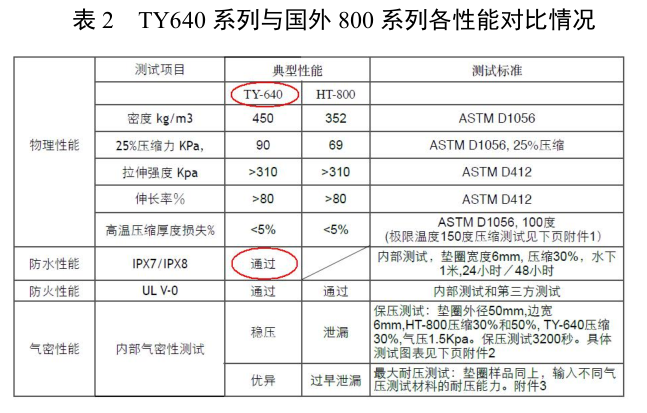
2.2.2 Waterproof performance under long-term use conditions
We all know that the service life of new energy vehicles is generally more than 8 years, and their core component battery pack must also have the same service life, so the same applies to sealing materials. For silicone rubber, it has excellent weather resistance, but as a sealing material, it also needs to have low compression permanent deformation, otherwise the waterproof performance and airtightness will decrease in the later stage. For this reason, when conducting test and analysis, we first conducted a series of waterproof and airtight performance tests on foam materials, then carried out various aging treatments, and finally conducted waterproof and airtight tests to investigate the changes before and after.
At present, the waterproof test of silicone rubber foam material is carried out in 24 hours and 48 hours when it is compressed by 30% under one meter of water. The experiment found that TY640 series can pass, but the passing rate of 800 series silicone rubber abroad after many tests is low, and domestic high-temperature rubber can not pass the waterproof test. Of course, the waterproofing of battery packs is not limited to 24 or 48 hours, it should be longer, preferably ensuring waterproofing for more than 8 years. Due to the long-term compression deformation state of silicone rubber in practical applications, it is more prone to permanent deformation at high temperatures, so the performance requirements for high-temperature deformation of silicone rubber itself are very high. For this purpose, we conducted the following high-temperature test, increasing the test temperature from the general standard of 100 ℃ to 150 ℃, and then examined the thickness loss. See the test results in the table below:
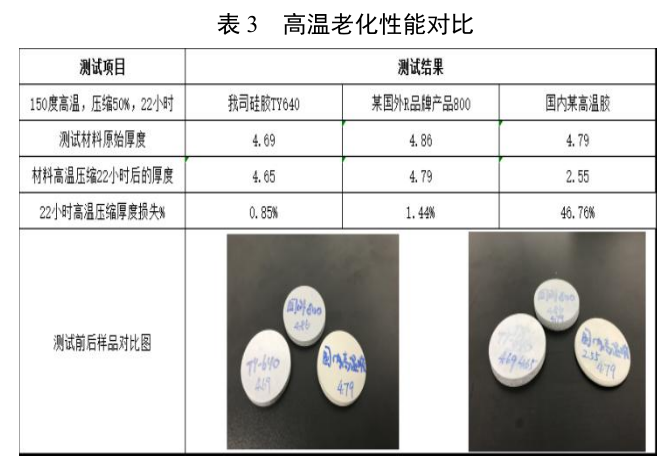
From the above experimental data, it can be concluded that the thickness loss of TY640 silicone rubber at high temperatures is smaller than that of foreign 800 series silicone rubber and a certain domestic high-temperature rubber. Moreover, we conducted further waterproof performance tests on the aged products, and TY640 silicone rubber still maintained good waterproof performance. At the same time, we also carried out a high-temperature aging test on a domestic high-temperature adhesive. Before the test, the foam adhesive showed excellent water resistance and air tightness. However, through tests under different aging conditions, it was found that the foam silicone rubber had overall collapse, with a large thickness loss, which could not be recovered, resulting in the failure of air tightness and water tightness in the later period. The reason for this is that this series of silicone rubber foam is made of high-temperature silicone rubber. Its molecular structure determines that the compression permanent deformation is large, and this performance cannot be compared with that of liquid silicone rubber.
3 Waterproof testing verification
According to the above analysis of waterproof design, we can know that the following key factors affect the waterproof performance of silicone rubber foaming sealing strip: the rebound force generated after compression of silicone rubber foaming sealing strip, the material of silicone rubber foam, and the apparent force of silicone rubber foam under long-term high-temperature compression. Based on the above factors, it can be concluded that the performance of TY640 series and foreign 800 series products is relatively better than that of a certain high-temperature adhesive series product in China, which can better protect the battery pack of new energy vehicles and ensure their safety during use. The following waterproof test results better validate this viewpoint:
We conducted a universal waterproof test on TY640 series, foreign 800 series, and a certain high-temperature rubber in China. The test conditions were that the silicone rubber foam sealing strip was compressed by 30%, and the test results were checked after 48 hours at a water depth of one meter, as shown in the table below:
Table 4 Waterproof Experimental Test
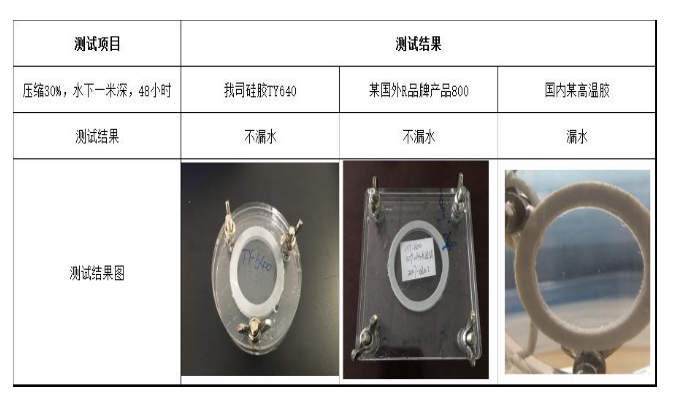
According to the above table, it can be seen that the experimental results of this waterproof test show that both our TY640 series products and foreign 800 series products passed the test, while a certain high-temperature adhesive in China did not pass the test and has leaked water. It can be seen that our TY640 series products and foreign 800 series products have excellent waterproof performance. However, according to our long-term experimental results, foreign 800 series products exhibit unstable performance under 30% compression for 48 hours, and fail waterproof tests under compression below 30% for 48 hours. Therefore, considering all factors, using TY640 series products for waterproof protection of battery packs has a more significant effect and more stable performance.
4 Conclusion
From the above discussion, we can see that when using silicone rubber foam material to seal the battery pack, there are many factors that affect the sealing performance, which are mainly related to the CFD size generated by the contact surface between the sealing strip and the box, the pore structure type of the foam sealing strip, aging and other factors. At the same time, according to the needs of customers, a new closed cell foam silicone rubber has been developed based on TY640. Compared with the current closed cell silicone rubber on the market, it has the same air tightness and water resistance, and after aging, it also has the characteristics of rapid resilience and small thickness loss, and the air tightness and water resistance are still maintained after aging. Of course, in addition to the performance of foam materials, the sealing and waterproofing of battery packs are also related to the design and structure of sealing strips and battery packs. In this regard, according to long-term experimental test analysis and actual verification, we can currently provide a complete set of waterproof solutions for battery packs, including what kind of bottom plate and shell materials have the best waterproof effect, what kind of sealing strips have the best cross-sectional area, how to deal with bulges and other issues.
Original submission URL: http://www.evpartner.com/news/4/detail-34040.html
Recommend